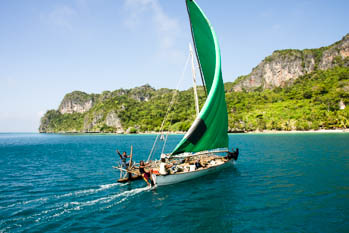
Tenaya
August
2013
Part One
Panasia Island
The Louisiades, PNG
| |
| HOME |
| About Tenaya |
| About Us |
| Latest Update |
| Logs from Current Year |
| Logs from Previous Years |
| Katie's View |
| Route Map |
| Links |
| Contact Us |
![]()
August 4, 2013
11 07'.89S 152 19'.94E
Papua New Guinea. The name conjures up images from National Geographic magazines and documentaries of primitive people and fierce warriors dressed in paint, grass, jute and leaves living in huts deep in the jungle.
That may be true for some tribes in the interior of the mainland but it's quite different in the Louisiade Archipelago of eastern Papua New Guinea. True, some islands are not safe to anchor in as young 'raskols' have stolen things off yachts and even come aboard at night with guns and knives to loot, but here on Panasia Island the folks are kind, hospitable and happy to have visitors in their bay.
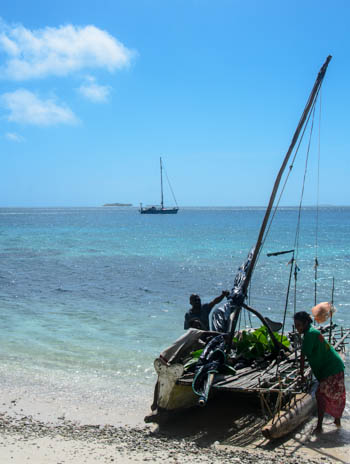
Exactly four days after leaving Cairns we cleared the uncharted pass through the reef at the northeastern edge of Panasia Island. Pana means island in the local language. Sia means rock. It describes the island well. Tall limestone cliffs rise straight out of the brilliant blue and green water while dense bush clings to all but the steepest walls. Palm trees sway in the breeze on the small sandy beach. There are no other yachts in sight. It feels as though we've sailed into paradise.
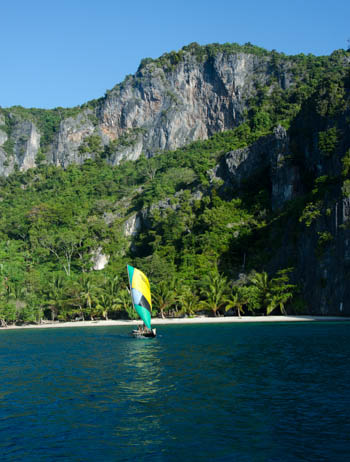
John and Gwen live in the shadow of the the towering peaks with their family. They planted coconut, banana and pawpaw (papaya) trees several years ago. When the garden could sustain them, they moved over from the other side of the island. John was born on Small Panasia, an island immediately to the west. He inherited this land from his mother and shares it with his brother, Rodney, and adopted brother, Juda.

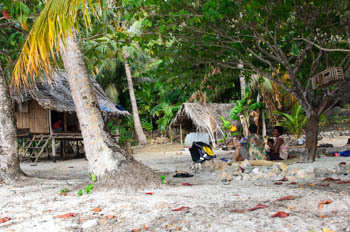
John, Gwen, their son, Kanon, his wife Margaret, Rodney and his wife, Katherine welcomed us warmly. Rodney sent us back to the boat with four fresh crayfish tails. What a wonderful treat and excellent first meal after nibbling on passage food!
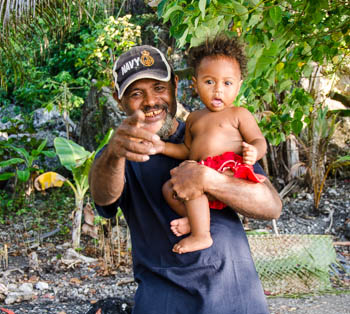
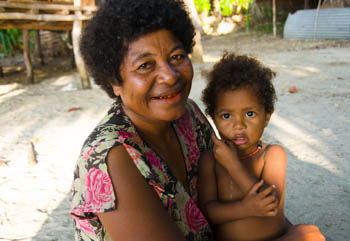

Ten miles across the big lagoon is Utian Island, known as Brooker Island. People sail their dugout outrigger canoes between the islands. They leak like crazy and someone is always bailing, but the canoes take off in the tradewinds and carry folks quickly and safely. Some sails are made of sail cloth but most are made from nylon, canvas or plastic tarps, or a combination.
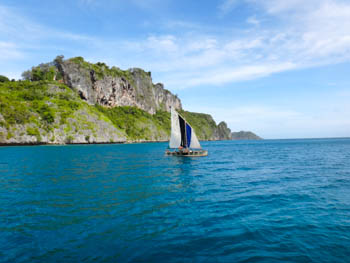
The day after we arrived we had a steady stream of visitors. They came in sailing canoes, dugout canoes and even an odd, tri-hulled paddleboard. A yacht means trading opportunities. The people have very little and are desperate for many basic items.
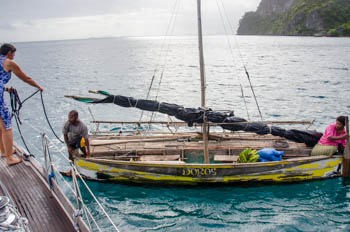
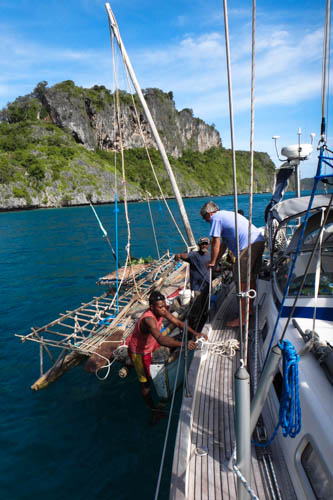

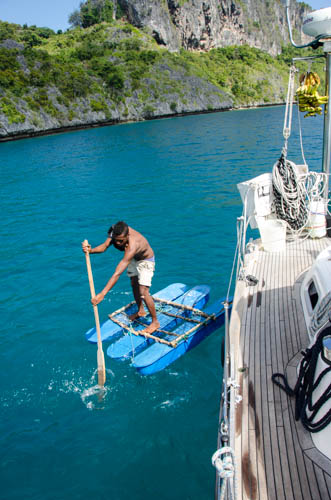

A marvelous cornucopia of items grown on the island or found in the sea was loaded onto Tenaya's deck before the people came aboard. We were offered delicious pawpaw, sweet eating and cooking bananas, various flavors of yams, potatoes, pumpkins, green coconuts, limes, eggs, baskets and clay pots.
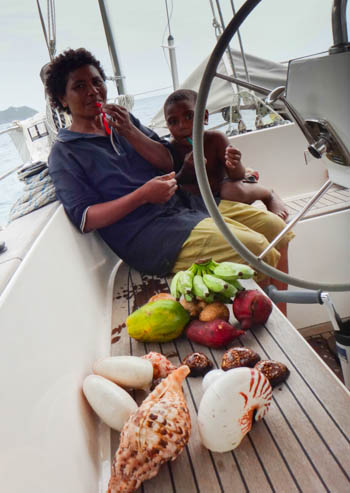
Clothing was the first thing we were asked for. Why the missionaries convinced people living in an ideal climate to wear modest western clothes is beyond me. There are no stores here and it doesn't appear modern missionaries make regular clothes drops. The people are at the mercy of passing yachts and we ran out too quickly. So anyone sailing this way, please bring clothes for all ages!
Besides clothes, they traded for sugar, flour, rice, sewing needles, thread, fabric, fish hooks, rope, band-aids, antiseptic ointment, flashlights, reading glasses... you name it, they need it.

Russ and Rozlynn sailed from California and crossed the Pacific the same year we did, in 2010. They opted to sell Worrall Wind in Australia and continue their world travels on land. Russ is a retired optometrist and gave us over 100 pair of glasses labeled by strength. They are a big hit! Of course, we must also give a Nat Geo, Alert Diver or Blue Water Sailing magazine so they have something to read.
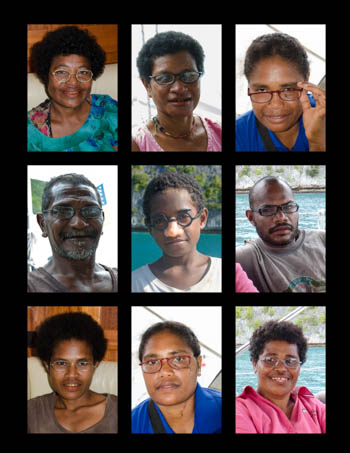
How do they transport eggs on a leaking, bouncing sailing canoe? In a bowl full of sand! To my surprise, Linda and Frank Junior dug out six chicken eggs and one bush fowl egg. They were amazed I did not know this trick.
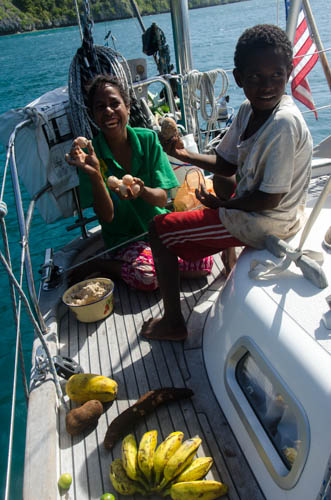
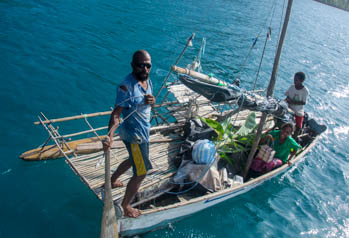
We met Wayne and Barbara from Casper at the yacht club at Rosslyn Bay, Australia. They sailed to the Louisiades two years ago and were smitten by the kind people on Brooker Island. Twice they tried to mail a package to their friends there but both times it was returned. They asked us to deliver it for them.
Each gift was individually wrapped with a name taped on. When Olive and James climbed aboard and said they were from Brooker, I recognized the names and ran downstairs for their present. They were thrilled!
Brooker has a shallow, narrow passage blasted through the reef and we were not keen to go there. James and Olive assured us they would deliver the rest of the package from Casper as well as several photos for the friends of the Totem crew.

Both Linda and Maggie gave us large bush fowl eggs. When I noticed one was cracked, I put them all in a pan to boil. Once they seemed cooked, I drained and rinsed them. My thumb went through one shell.
In case you were wondering, bush fowl chicks emerge from their eggs fully wrapped in black feathers. I was too grossed out to investigate further so dumped all the eggs overboard. The next morning two small white-tipped reef sharks were swimming around Tenaya. Maybe they liked the baby bushfowl or perhaps they ate the fish that ate the eggs?

By the end of the second day we were exhausted. People kept asking for more and more and eventually we had to say that we had given enough, we had to save some things for people on other islands. They have no conception of how much things cost so it was just as easy to ask for a sewing machine, jacket, backpack, solar flashlight or a hand drill as it was to request a bag of sugar.
Jim came below at the end of the day and said, "This is the first time I've ever looked out on the horizon hoping to see another boat coming into the anchorage."
The anchorage at Panasia is calm and the tradewinds keep the boat cool and bug free although we didn't see any flying pests on shore. It's a beautiful place to swim, kayak and snorkel with shallow bommies in clear, warm water.
Around the northern side is a pretty beach at the base of a limestone wall with interesting rock formations. At the far end is a ladder which goes high up on the cliff to Robinson's garden. He lives on Brooker but has his garden here on Panasia.
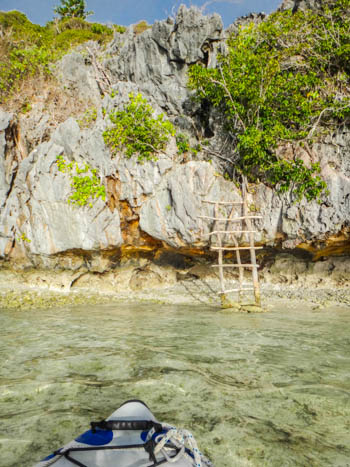
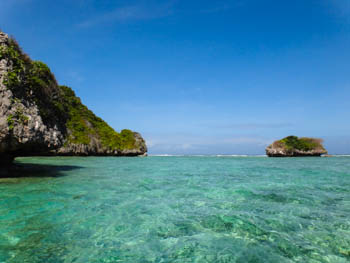
The southern side of the island is less steep so most people plant their gardens there. A shallow turquoise lagoon extends a half mile out to the reef and there is a long, sandy beach about a mile long. We saw one set of footprints and no people.
Near the end of the beach is the village where Juda and Alison live along with their son, Nassone and his wife, Maggie. Their other son, Mackenzie is on Brooker at the moment recovering from an accident. He tried to break open a cooking gas canister and it exploded, shattering his right tibia, fibula and some bones in his foot.
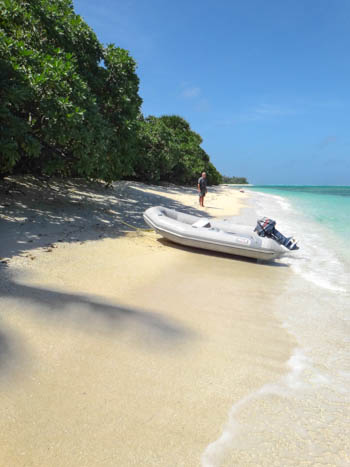
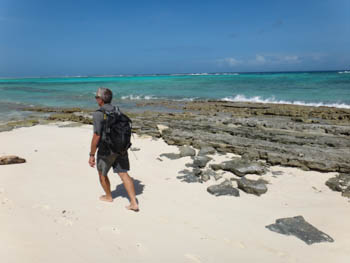
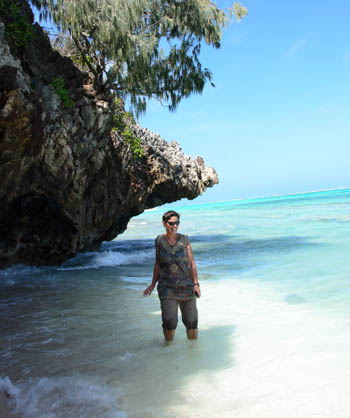
When Juda and Alison came to Tenaya they invited us to their side of the island to see a large cave. We took the dinghy over and walked along the beach until we came upon a large rock but never saw the village so turned around. We didn't go far enough. A few days later Gwen went with us to lead the way.

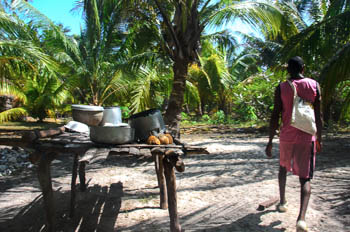
The ladies sat on the raised veranda as the men stood and talked. Every so often one of the ladies would spit a stream of orange over the side and down to the sand. It seems every here over the age of six chews betel nut because all their teeth are stained red.
Juda, Nassone and Maggie led us through the bush and up to the cave. You must climb a ladder, pass through a hole and decend a ladder on the other side where it opens up to a large, dimly lit space not unlike a medieval European cathedral or something Gaudi might have designed. A brackish pool glistens in one corner.

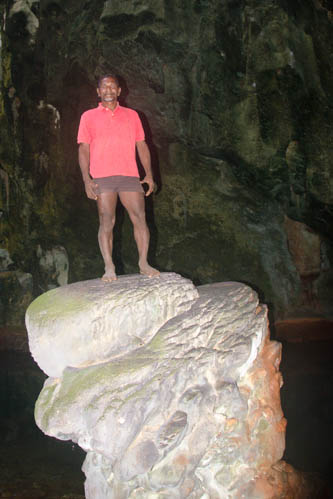
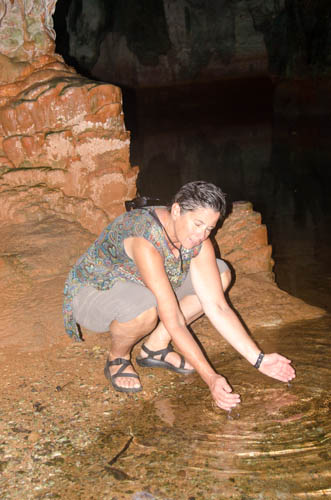
We spent ten days enjoying the pleasant company of Gwen and John and the two little girls, Sevolina who they are raising for their daughter, Dorothy, and Ulu who is Kanon and Margaret's baby.
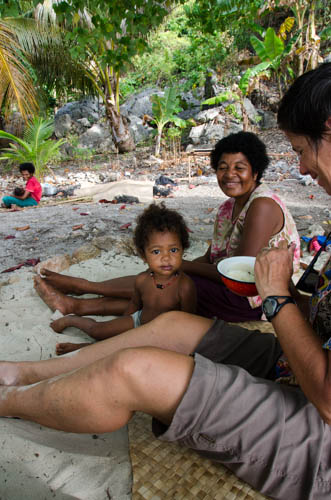
Jim fixed Gwen's sewing machine so John sailed over to Brooker and brought back two more to repair. The government gives sewing machines to the ladies' fellowship group on Brooker but does not follow up with maintenance and repairs. Jim was able to get those working as well.
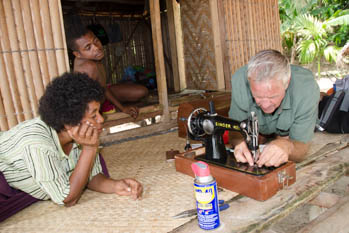
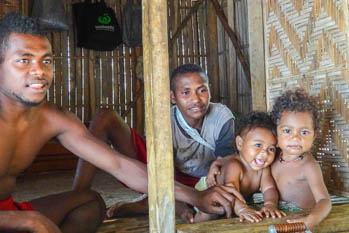
We received cooking bananas (top) small, sweet eating bananas (left) and eating/cooking bananas (huge bunch). We've been eating bananas everyday in our yogurt, as snacks and in smoothies. The cooking bananas are tasty boiled in green coconut water with a little curry powder. When they ripened too much I mashed them and made two loaves of banana bread. I did the same thing with the big bunch and froze the rest for more smoothies. We're still eating banana bread!

Frank and Linda came by Tenaya again to visit. Frank needed better line for his sailing canoe. He was using narrow polypropylene line which cut into his hand. Jim gave him 15 meters of the climbing rope Chris gave us when we were in California. That rope is helping more and more people! In return, we received four crayfish. They were killed with a spear gun and it broke my heart to see a small female's underside filled with eggs.

The same day Kanon wanted to sell us six crayfish to buy cigarettes on Brooker. We said we had no kina so declined the lobster thinking they would eat it themselves as they are not Seventh Day Adventists. But Gwen gave them to us anyway.
We asked Kanon and John not to give us any more, explaining that crayfish are special creatures that take many years to grow. Although they taste delicious and dim dims (white people) love them, they should take care not to deplete the population. John understood, "We want to have them for our children's children."
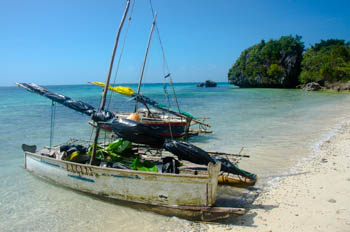
The women on Brooker Island make clay pottery. It's not found on any other island in the Louisiades but is in demand so bowls, pots and vases are often traded. Gwen is from Brooker. We went ashore one day to find her making two vases. It was fascinating watching her create perfectly symmetrical orbs as she chatted away.
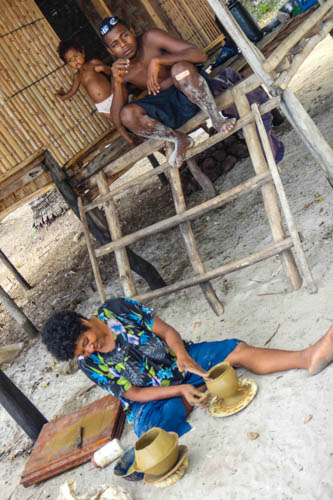
The afternoon before we left we went ashore to say good-bye. It was very sad; we had grown to like each other very much. Gwen gave me the larger vase. She showed me the smaller vase and said the base had broken off in the fire. I will treasure it. It is packed safely away on Tenaya so will not break during a rough passage.

John paddled out to shake our hands good-bye on the morning we left. He presented us with an abalaga, a ceremonial axe-like carving that is very special. He gave two for his wife, one for a sailing canoe and had this one on his wall. He said he thought about it overnight and discussed it with Gwen because he really likes it, but they wanted us to have it. We were speechless. His generosity was so much greater than ours. Ahtay woh hah, John and Gwen. Thank you. We will cherish it and our memories of you.
Click here to see a short video
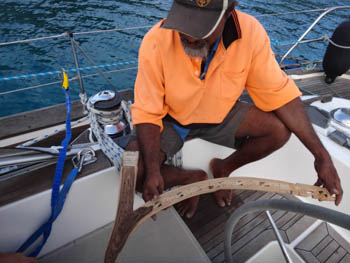
Many crews sailing across the Pacific and continuing on to Singapore or Thailand join a rally to simplify customs and immigration hurdles in Indonesia. From these points they can either ship their boats to the Med or continue sailing to South Africa. The Somali pirate situation is still too dangerous to contemplate sailing through the Red Sea on a small yacht.
We're not big on rallys and reading the blogs of those who did the Cairns to Darwin leg don't make those 1500 miles sound like much fun. Exploring new places with dozens of other yachts and only seeing 'local life' staged for our benefit appeals to us even less. We weren't sure how we would proceed until Duncan on Matsu came to our rescue.
He knows how much we enjoyed interacting with the locals in Vanuatu. He and Audre have sailed all over the world and feel those living on some of the islands of PNG are the nicest indigenous people they have ever met. He gave us a list of places to visit and to avoid and said to Google Hermit Islands for more information.
When I did I found Totem's excellent blog where I read they had similar experiences as those we had on Tanna. We began corresponding and Behan and Jamie sent us their tracks into many of the anchorages.
Many thanks to the crews of Matsu and Totem for their detailed information. Without it, we would have surely passed by this wonderful island and missed meeting all these friendly people.
Go to August 2013 Part Two - Panapompom, The Louisiades, Papua New Guinea
